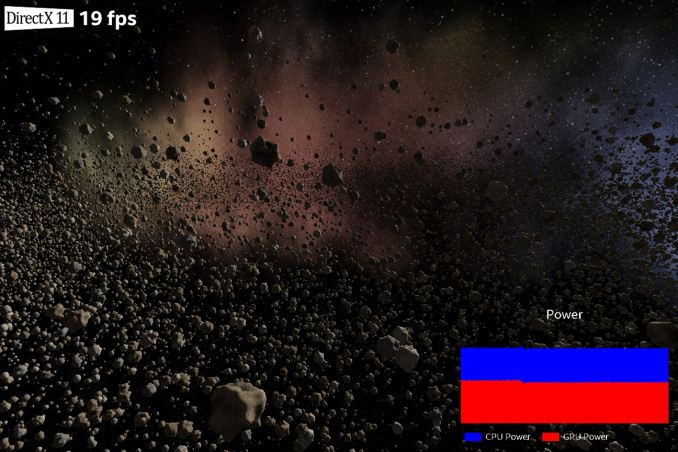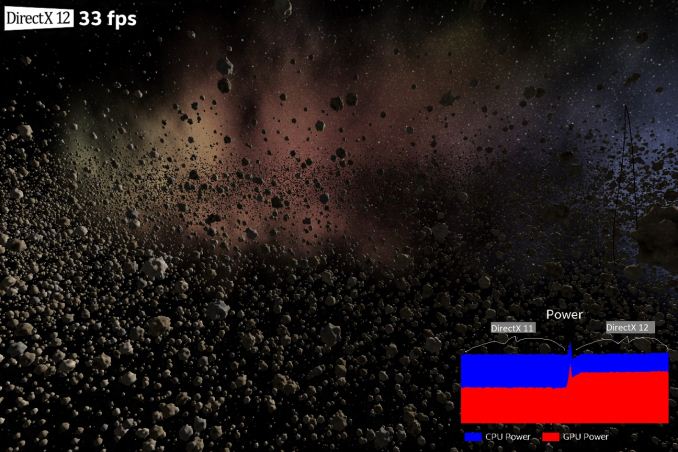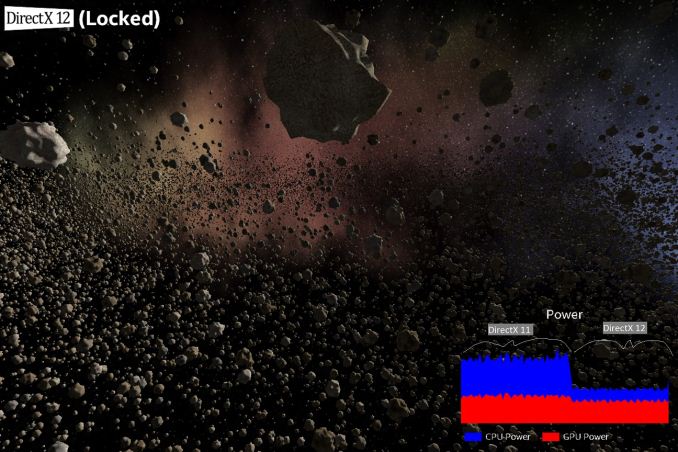Intel Demonstrates Direct3D 12 Performance and Power Improvements
by Stephen Barrett & Ryan Smith on August 15, 2014 6:00 AM EST
Since the introduction of Direct3D 12 and other low-level graphics APIs, the bulk of our focus has been on the high end. One of the most immediate benefits to these new APIs is their ability to better scale out with multiple threads and alleviate CPU bottlenecking, which has been a growing problem over the years due to GPU performance gains outpacing CPU performance gains.
However at the opposite end of the spectrum and away from the performance benefits are the efficiency benefits, and those are gains that haven’t been covered nearly as well. With that subject in mind, Intel is doing just that this week at SIGGRAPH 2014, where the company is showcasing both the performance and efficiency gains from Direct3D 12 on their hardware.
When it comes to power efficiency Intel stands to be among the biggest beneficiaries of Direct3D 12 due to the fact that they exclusvely ship their GPUs as part of an integrated CPU/GPU product. Because the GPU and CPU portions of their chips share a thermal and power budget, by reducing the software/CPU overhead of Direct3D, Intel can offer both improved performance and power usage with the exact same silicon in the same thermal environment. With Intel's recent focus on power consumption, mobile form factors, and chips like Core M, Direct3D 12 is an obvious boon to Intel.
Intel wisely demonstrated this improvement using a modern low-power mobile device: the Microsoft Surface Pro 3. For this demo Intel is using the Core i5-4300U version, Microsoft’s middle of the road model that clocks up to 2.9GHz on the CPU and features one of Intel’s HD 4400 GPUs, with a maximum GPU clockspeed of 1.1GHz. In our testing, we found the Surface Pro 3 to be thermally constrained – throttling when met with a medium to long duration GPU task. Broadwell should go a long way to improve the situation, and so should Direct3D 12 for current and future Intel devices.
To demonstrate the benefits of Direct3D 12, Intel put together a tech demo that renders 50,000 unique asteroid objects floating in space. The demo can operate in maximum performance mode with the frame rate unrestricted, as well as a fixed frame rate mode to limit CPU and GPU utilization in order to reduce power consumption. The demo can also dynamically switch between making Direct3D 11 and Direct3D 12 API calls. Additionally, an overlay shows power consumption of both the CPU and GPU portions of the Intel processor.
Intel states this demo data was taken after steady-state thermals were reached.
In the performance mode, Direct3D 11 reaches 19 frames per second and the power consumption is roughly evenly split between CPU and GPU. Confirming that while this is a graphical demo, there is significant CPU activity and overhead from handling so many draw calls.
After dynamically switching to Direct3D 12 while in performance mode, the frames per second jumps nearly 75% to 33fps and the power consumption split goes from 50/50 (CPU/GPU) to 25/75. The lower CPU overhead of making Direct3D 12 API calls versus Direct3D 11 API calls allows Intel's processor to maintain its thermal profile but shift more of its power budget to the GPU, improving performance.
Finally, in the power efficiency focused fixed frame rate mode, switching between Direct3D 11 and 12 slightly reduces GPU power consumption but dramatically reduces CPU power consumption, all while maintaining the same 19fps frame rate. Intel's data shows a 50% total power reduction, virtually all of which comes from CPU power savings. As Intel notes, not only do they save power from having to do less work overall, but they also save power because they are able to better distribute the workload over more CPU cores, allowing each core in turn to run at a lower clockspeed and voltage for greater power efficiency.
To put these numbers in perspective, a 50% reduction in power consumption is about what we would see from a new silicon process (i.e. moving from 22nm to 14nm), so to achieve such a reduction in consumption with software alone is a very significant result and a feather in Microsoft’s cap for Direct3D 12. If this carries over to when DirectX 12 games and applications launch in Q4 2015, it could help usher in a new era of mobile gaming and high end graphics. It is not often we see such a substantial power and performance improvement from a software update.













42 Comments
View All Comments
iLovefloss - Friday, August 15, 2014 - link
Or a very nicely made Convertible. Which are getting popular.iLovefloss - Friday, August 15, 2014 - link
Wait, what? The Surface Pro line is most definitely part of the mobile market. It is a fucking tablet. It is mobile unlike transportable gaming machines. It's just on the high end. Implying that the Surface Pro isn't a mobile device is like implying that ultrabooks aren't laptops because they have a touch screen and are expensive or implying that the rMBP is too expensive to count as a laptop.Anyway, what's your point? DirectX 12 direct benefit is that it'll allow more power hungry CPUs in smaller form factors. A device that is known to suffer form thermal throttling can now run smoothly thanks to the efficiency of the new API. Why does it matter that the device that they tested it on has a relatively small market share? The test proves Intel's point sufficiently: DirectX 12 helps with battery life, thermals, and performance.
Alexey291 - Monday, August 18, 2014 - link
Well that's a test show. I've seen one of those regarding every DX going back to 9 and beyond (was too young to care before 9 really) and every single one promised lowered overheads, higher efficiency etc etc. In reality we have the mess that we have. But yeah maybe this time they ACTUALLY did something good. Though I have doubts once more.And besides I'm all for greater efficiency. I just find the angry guy sweet. He seems so into this :)
B3an - Friday, August 15, 2014 - link
You think an iPad with crippled Office is going to compare to a full PC Surface Pro? You think people the Surface Pro is aimed at would even consider an iPad? You're the one who needs a shrink you delusional moron.Alexey291 - Monday, August 18, 2014 - link
Well considering that most people who this device is aimed at (looking at MS marketing) already own either an ipad or an mba or both... Yeah I do seriously think they'd consider an ipad first or the newer mba when one comes out.Plus surfaces run windows. That's enough of a deterrent for A LOT of people. You might be surprised just how many people would rather never have to run antiviruses on their tablets.
But do continue being angry. Its really cute.
lilmoe - Saturday, August 16, 2014 - link
You're not seriously comparing an iPad to Surface (any Surface!) are you?Alexey291 - Monday, August 18, 2014 - link
I'd seriously rather have ANYTHING than a surface rt. Nexus 2012 even rather than surface rt. What a waste of silicon that was....And well yeah the pro's? I'd rather have a good tablet at half the price (not necessarily an ipad even) or a decent ultrabook at a similar price. Because either of those would be better :)
Alexey291 - Friday, August 15, 2014 - link
Sounds like the usual:1 year ahead "look at the performance benefits!"
1 year after "look at how much slower the 1st generation of dx12 hardware runs with dx12 functions enabled!"
Metroid - Friday, August 15, 2014 - link
This is big, no matter how you see, can't deny this is what most of us were expecting, dx12 will probably have the same effect for GPU's as Conroe had for CPU's, but we cant expect the same cause CPU's date back to old apps whereas games are dx related versions, so unless the game runs as dx12, we will not see any gain about that.Alexey291 - Friday, August 15, 2014 - link
this would be big if adoption would just SUDDENLY happen and would be "perfect".In reality though the majority of features will not be seen for years to come. I mean even now the list of DX11 games is actually quite small. And some (terrible) AAA titles still come out as DX9 only (I'm looking at you X:Rebirth).
Most likely the consumers will never actually see any performance benefits per se. Instead the games will become more complex (graphically etc) and would look better. Leaving us with essentially more detail for the same performance. Which is arguably ISN'T what low power mobile devices would want.
But obviously we shall see :)